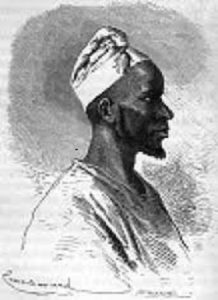While reading Sundiata: Lion King of Mali by David Wisniewski, I couldn’t help but wonder how much of it was based on historical fact and how much of it was exaggerated through the spreading of the story. I included a picture of Sundiata Keita below, who the story was based off of. As silly as it is of me to say this, while the story had an encouraging message, I couldn't let go of just how cliché the storyline was (unsurprisingly). I'm likely comparing it with the other source texts we've read, with their more grotesque and odd scenes. In this sense, the simplicity of the story was refreshing and very predictable (and also more suitable for younger readers).
 |
| Sundiata Keita Source: URL |
There were certain scenes in the story that reminded me closely of Black Panther, to the point where the movie clips were setting up the scene for Sundiata’s story in my mind. This includes the part when Sundiata and his mother run away, reminiscent of the scene in the movie where T’Challa and his family flee due to the threat of the new king. The strengthening that Sundiata went through over time and even the help he received from neighboring kings reflected similar events in Black Panther. The fact that Sundiata’s story, The Lion King, and Black Panther all take place in Africa and are so mainstream and popular may speak to not only the lack of popular media highlighting different aspects of African culture, but also the reduction of stories set in Africa into popular tropes, consequently generalizing African culture (like how people have a tendency to view Africa as one thing rather than the countries that make up it).
Regardless, I really liked a specific line in the story, when the griot comforted the king and told him, “‘How small the seed from which a great tree springs… and what storms the first sprout endures! Sundiata will grow in his own time, not yours, Great King!’” In my opinion, this can be applied beyond the story and in the present day. With people, not everyone grows and develops at the same rate, and, as stated in Mulan, “The flower that blooms in adversity is the most rare and beautiful of all.” The struggles that individuals go through contribute toward developing their character and beliefs, and Sundiata in this story grew and matured in this same way.
I found the author’s note at the end of the book interesting as well, especially as Wisniewski adapted and retold the story of Sundiata from another version of the story, Sundiata: An Epic of Old Mali, which itself was documented from oral retellings. The author added his own illustrations in his version, similar to what Disney does through their films. The way he mentions the changes he made after consulting professionals also builds on his credibility and the accuracy of his version. He acknowledges that gave the nine witches a “‘foreign’ costume to create a heightened sense of mystery and fear” when they “would have dressed no differently from the rest of the community,” and this might be in part what Disney does in their retellings (aka changes a lot of things) to capture more of their audience and make the story and setting more dramatic. I thought this little blurb at the end of the book was useful insight that could be related back to how Disney makes their adaptations.
Overall, the illustrations incorporated in the story helped in bringing the story alive, making it different from the other source texts we’ve read in class. (I guess Mary Poppins had some illustrations as well, but it was sparse and not even colorful.) I’m excited to see how Disney further animates this story and puts their own spin on it, with lions instead of humans!



No comments:
Post a Comment